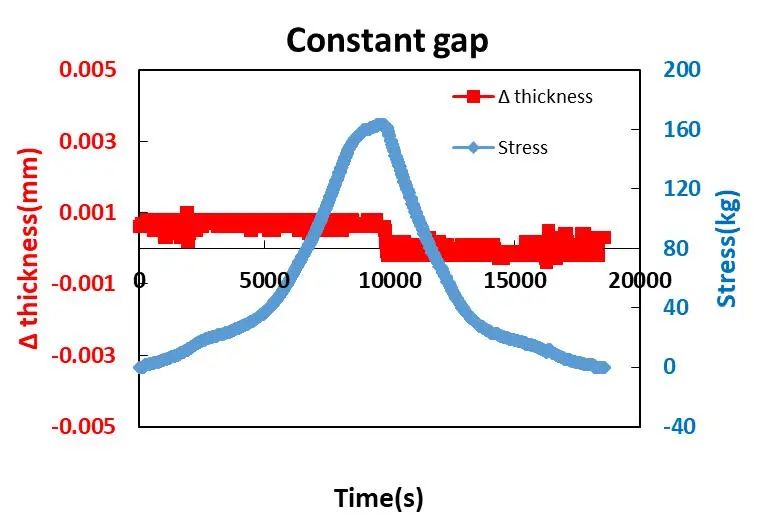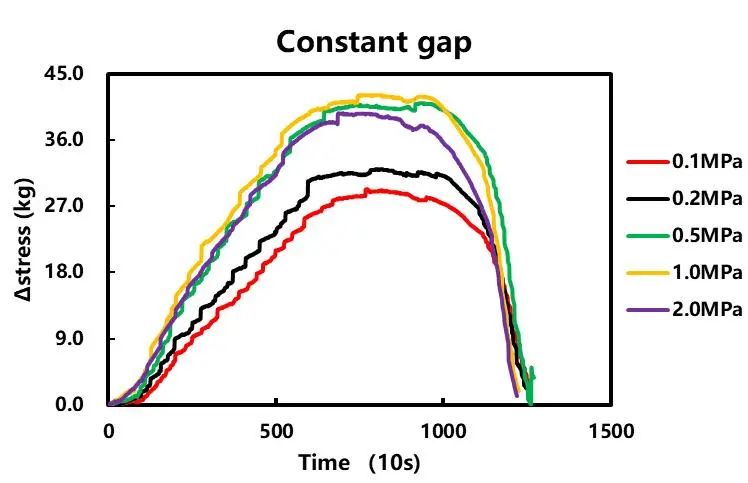Parameters Selection Basis for Battery Swelling Performance Test
During the charging and discharging process of lithium-ion batteries, the swelling of the battery cell will be caused by the structural swelling of the positive and negative electrodes and the gas generation by the decomposition of the electrolyte. When the stress applied on the surface of the cell is constant, the cell shows a change in thickness, and when the initial thickness of the cell is controlled to be constant, the cell shows a change in stress.
Usually, when testing the swelling behavior of the battery, it is necessary to control different boundary conditions to obtain the change of the swelling thickness or swelling force of the battery. However, different control parameters will significantly affect the measured swelling data. The in-situ swelling test system SWE series launched by IEST, as shown in Figure 1, can characterize the swelling behavior of the cell in-situ. How to set parameters in different measurement modes, which is very important to get accurate and reliable inflation data.
Figure 1. IEST in-situ swelling test system SWE series
There are two measurement modes for the SWE series to characterize the swelling behavior of the cell: constant pressure and constant gap. The following describes the parameter settings of the two modes respectively.
1.Constant Pressure Mode
In the constant pressure mode, the pressure applied to the surface of the cell is constant, and the pressure during charging and discharging of the cell is maintained in real time through a high-precision pressure control system, and the thickness change curve is collected at the same time, as shown in Figure 2. This mode is often used to compare the difference in swelling behavior of different materials, such as the comparison of the swelling thickness of different silicon carbon materials. The setting of the pressure parameter is related to the length and width of the cell, in general, as the applied pressure increases, the longitudinal pressure on the cell is also increasing, and the measured swelling thickness during the charge and discharge process is getting smaller and smaller, as shown in Figure 3, but when the pressure is too high, the polarization of the charging and discharging of the battery will be too large, which will affect the performance of the battery, so it is necessary to choose a reasonable pressure. Usually, people in the industry will choose a pressure of 0.2 MPa to characterize the in-situ swelling thickness of the battery. There is no requirement for the SOC state of the battery cell before the test in this mode, and the analysis focuses on comparing the difference in thickness between full and full discharge.

Figure 2. Schematic diagram of constant pressure and thickness variation

Figure3. In-situ swelling thickness curves under different pressure conditions
2.Constant Gap Mode
In the constant gap mode, an initial preload will be applied to the cell first, and the cell gap corresponding to the preload condition will be kept constant through the high-precision displacement control system, and the pressure change during the charging and discharging process of the cell will be collected in real time Curve, as shown in Figure 4. This mode is usually used in cell/module/Pack design or simulation departments. By comparing different initial preload conditions, the gap between the control cells is different, and then the stiffness of bound boundary materials is analyzed, such as comparing different module shells or different Cushioning difference. The setting of the pre-tightening force parameter affects the initial gap of the battery cell. The larger the pre-tightening force is, the smaller the gap corresponding to the battery cell is, and the greater the swelling force measured during the subsequent charging and discharging process is, but when the pre-tightening force reaches a certain level, the swelling force of the battery cell will change relatively smoothly, if you continue to increase the pre-tightening force, the corresponding battery cell gap will be smaller, which will increase the polarization of the charging and discharging of the battery cell and affect the performance of the battery cell. Therefore, it is necessary to choose a reasonable pre-tightening force to ensure a suitable cell gap, people in the industry will choose a pressure of 0.2MPa as the preload to characterize the in-situ swelling force of the cell. In addition, the initial SOC state of the cell is different, which will affect the gap control amount of the cell. For example, under the same preload condition, the cell gap of 0% SOC is smaller than the cell gap of 100% SOC, the difference in swelling force measured at full charge and discharge under these two states will also be different. Therefore, we try to keep the initial SOC state of the battery cell consistent when characterizing swelling force, and usually select the battery cell in the fully discharged state for testing.

Figure 4. Schematic diagram of constant gap swelling force variation

Figure 5. Schematic diagram of the swelling force change at the constant gap corresponding to different preloading forces
Summary
When characterizing the swelling performance of the battery, the constant pressure and constant gap modes have different application scenarios and test parameters. Usually, when evaluating materials, the constant pressure mode is preferred to characterize the cell swelling thickness. At this time, there is no special requirement on the initial SOC of the cell, in cell design, the constant gap mode is more preferred to characterize the swelling force of the cell. At this time, the initial SOC of the cell will greatly affect the subsequent test results, and the cell in the fully discharged state can be selected for testing. In addition, for the setting of the initial pre-tightening force, the pressure of 0.2MPa is applied to the surface of the cell as the initial condition of constant pressure or constant gap in the industry.
Reference
1. Li Linyang, He Fan, Lv Xixiang. Analysis method for swelling displacement of lithium battery modules [J]. Power Technology, 2023, 47(5): 632-634.
2. Liang Haobin, Du Jianhua, Hao Xin, et al. Research status of lithium battery swelling formation mechanism [J]. Energy Storage Science and Technology, 2021, 10(2): 647-657.
3.MARTIN W, JORG K, DIRK U S. Investigation of the influence of different bracing of automotive pouch cells on cyclic lifetime and impedance spectra[J]. Journal of Energy Storage, 2019, 21:149-155.

